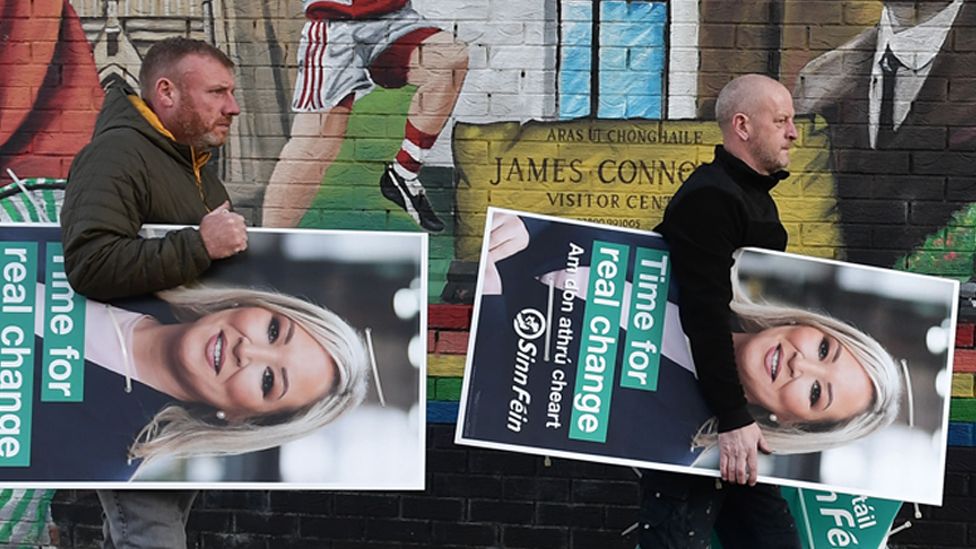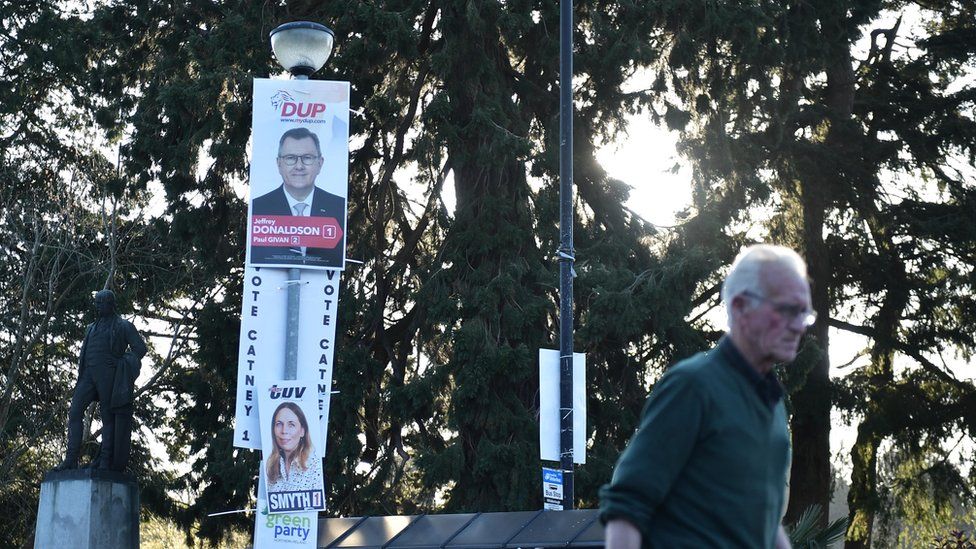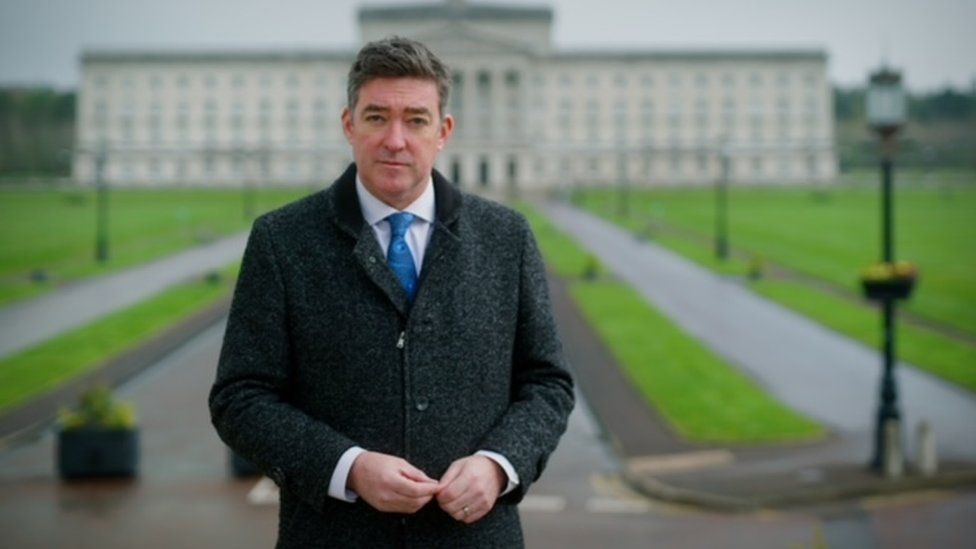But things are changing. These elections could deliver a significant outcome for the whole of the UK. For the first time in Northern Ireland’s 100-year existence, a nationalist party – Sinn Féin – may become the largest party.
Sinn Féin’s ultimate goal is for Northern Ireland to leave the UK and become one country with the Republic of Ireland.
“This is the most important election in our history,” says Jeffrey Donaldson, the leader of the Democratic Unionist Party (DUP), Sinn Féin’s long-time, bitter opponents at the ballot box.
But a victory for Sinn Féin doesn’t mean a border poll would be imminent. There are plenty of voters who may aspire to have one, but believe it would be too divisive right now.
That said, a Sinn Féin victory would bring more prominence and renewed energy to their campaign. It would also be a historic tipping point in a place which is still going through a delicate peace process, and could lead to months of political uncertainty.
With the Scottish National Party already in power in Scotland, having two parts of the UK with ardent nationalists as the largest parties would also create the image of a United Kingdom that has never looked less united.
Symbolic blow
The Good Friday agreement in 1998, which ended decades of violence in Northern Ireland, created a system in which the largest unionist and nationalist parties must govern together – but who won the most seats has always mattered.
A unionist party has always been returned as the largest party at Stormont, giving some reassurance to people who strongly see themselves as British and want remain part of the UK.

If Sinn Féin are the largest party, they would be entitled to fill the post of first minister, a major symbolic blow to unionists, even though the first minister and deputy, must govern together in equal partnership.
Sinn Féin was once known as the political wing of the armed paramilitary group the IRA, during the 30 years of armed conflict known as the Troubles. It stirs up deep emotions for those who remember.
On the Shankill Road, a loyalist area with shop windows adorned with union flags ahead of the Queen’s Jubilee, a man says under his breath: “I still don’t trust them as far as I can throw them.”
But Northern Ireland is a very different place now. So what is behind this potentially seismic shift?
Brexit has brought big problems for the DUP, the largest unionist party. Some unionists are angry that Prime Minister Boris Johnson agreed the Northern Ireland protocol, part of the Brexit deal which created a new trade border down the Irish sea.
They see this as a betrayal that threatens to erode Northern Ireland’s place in the UK, a step closer to a united Ireland that must be fiercely resisted.
That anger has led to the DUP losing votes to an even more hardline party, the Traditional Unionist Voice (TUV), which uses even more ferocious language to depict what they see as the dangers for unionists of the Brexit arrangements.
“If we do not kill the protocol, it will kill the union,” TUV leader Jim Allister told a recent protest rally.

- WHO SHOULD I VOTE FOR? How the Northern Ireland parties compare
- POSTCODE SEARCH: Is there an election in my area?
- WHAT’S HAPPENING WHERE? Really simple guide
- ELECTION ALERTS: Sign up for Northern Ireland election alerts

The problem for the DUP is that they are also losing voters in the other direction too. Many people are increasingly fed up with so-called Green and Orange politics – green for those who want Irish unification, orange which has become shorthand for unionism, referring to the unionist organisation the Orange Order.
Moderate unionists in particular are voting in larger numbers for centre-ground parties who do not align themselves with either. The cross-community Alliance party has seen a sharp rise in its vote share in recent elections, and could become the third biggest party in the assembly ahead of the other two traditional parties, the Ulster Unionist Party and the nationalist SDLP.
And frustration with perpetual “crisis politics” at Stormont is another factor. The uneasy forced coalition between unionists and nationalists since the Good Friday Agreement is fragile and has often collapsed.
“At least you’re running better than Stormont,” reads a sign held up to spur on competitors at the recent Belfast marathon.
For three of the past five years there was no assembly, after Sinn Féin pulled out. This year the DUP pulled out of the executive over the Brexit arrangements.
It leaves Northern Ireland in limbo, and public services stagnating without the ability to agree updated budgets and allocate millions of extra funding.
Voters moving to cross-community parties like Alliance and the Greens, will often tell you they just want to see an end to the system where one side can bring the whole house down.
Mood change
Unfortunately for them, there is likely to be more uncertainty after the votes are counted – the DUP says it will not return to the executive unless the new checks on goods over the Irish Sea are removed.
Polling research shows the splintering of the DUP vote is a major reason for Sinn Féin’s potential success.
“The unionist community have increasingly moved away from political unionist parties, so there has been a mood change that has taken place within unionism,” Peter Shirlow, from the Institute of Irish Studies at Liverpool University, explains.
“If the DUP does badly, it’s a unionist political crisis, not a constitutional crisis.”
If Sinn Féin was to emerge as the largest party, it would be quite some journey for a party whose former leader was at one time not even allowed to have his voice heard on television – instead Gerry Adams’ words would be spoken on the news by an actor.

Mr Adams always insisted he was not in the IRA, which was always met with great scepticism. Sinn Féin’s current leader Michelle O’Neill, unlike her predecessor Martin McGuinness, does not have an IRA past, and she represents the newer face of the party.
“Once they moved away from violence and appeared to fully embrace politics, you could see the Sinn Féin vote escalating quite quickly,” says Allison Morris, a political commentator who writes for the Belfast Telegraph. “I think that there’s enough space now between the conflict and Sinn Féin.”
Under O’Neill’s leadership, Sinn Féin has not put calls for a unification vote front and centre of its campaign, focusing instead on everyday issues like the cost of living. But there is deep suspicion among many unionists that Sinn Féin would revert to pushing for a border poll more prominently if they won.
“Sinn Féin’s top priorities in this election are tackling the cost of living crisis and supporting the health service,” O’Neill said at their manifesto launch.
While the DUP remains very socially conservative, opposed to abortion and same-sex marriage, Sinn Féin has had more success in appealing to younger voters, for example changing its policy to allow women access to abortions.
“It feels like progress to someone like me,” says Ryan Jennings, a young voter I meet on the Falls Road, not far from Sinn Féin’s Northern Ireland HQ.
We scroll through Sinn Féin’s social media feed, and spot Gerry Adams dancing to an old republican rebel song on TikTok. While it might feel slightly cringe worthy, it does show the party are more comfortable with lightening up a bit for a younger audience.
Although Sinn Féin have been consistently ahead in the polls, this election could be extremely tight, and some disillusioned DUP voters could come back into the fold.
So would a Sinn Féin victory lead to a border poll? In reality only about third of voters actually support holding a referendum in Northern Ireland. Under the Good Friday agreement, it is the UK government that has the power to call a border poll, and the dial would have to move a great deal more for there to be any prospect of that happening.
For now, while Northern Ireland may still be perceived from afar as a place dominated by the battle between unionism and nationalism, this often misunderstood part of the UK is increasingly being shaped by the growing number of people who feel somewhere in between.
The DUP, Sinn Féin, SDLP, UUP and Alliance are all taking part in the debate
Politicians from the five biggest parties in Northern Ireland are due to go head-to-head in the final TV debate of the assembly election campaign later.
Sir Jeffrey Donaldson of the Democratic Unionist Party, Sinn Féin’s Michelle O’Neill, the SDLP’s Colum Eastwood, the Ulster Unionist Party’s Doug Beattie and the Alliance Party’s Naomi Long, are to take part in BBC Northern Ireland’s The Leaders’ Debate.
They will set out their key policies and arguments in the final run-up to the Northern Ireland Assembly election on Thursday.
It is the second TV debate of the campaign, following the first on UTV on Sunday.
What time is The Leaders’ Debate?
The debate will be broadcast on BBC One Northern Ireland from 21:00 on Tuesday and will run for an hour. It will be moderated by BBC Spotlight NI’s Jim Fitzpatrick.
It will be broadcast at the same time on the BBC News Channel and iPlayer and will also be streamed live, with added analysis, on the BBC News NI website.

Jim said: “This is a crucial forum for debate between the leaders of the five main parties just two days before election day.
“It’s exciting to be putting them in front of a studio audience who will hold them and their policies to account with probing questions on the issues that matter to them.”
Who is taking part?
Sir Jeffrey Donaldson – DUP leader – He has argued that the DUP is the only unionist party which can stop Sinn Féin winning the most seats – a scenario in which he argues Sinn Féin would step up demands for a referendum on Irish unification. When asked if the DUP would take up the post of deputy first minister if it comes second behind Sinn Féin, Sir Jeffrey has not directly answered, but has said he is a democrat. He also argues that a vote for the DUP can help send a message to Westminster, Dublin and Brussels about unionist opposition to the Northern Ireland Protocol, to which he is strongly opposed, and has said the DUP will not enter into the power-sharing executive after the election unless steps are taken to dismantle the protocol.
Michelle O’Neill – Sinn Féin deputy leader – The party has put the cost of living crisis at the heart of the Sinn Féin campaign rather than its long-held ambition for a referendum on Irish unification. The party has campaigned under the slogan “time for real change” and she has said her priority is to show that politics works and to convince voters that “real change is possible”. That belief in Irish unity is still a key policy though, and she has said it would be “reckless” not to plan for the unification of Ireland.
Colum Eastwood – SDLP leader– He is not standing in the election as he is the Westminster MP for Foyle, but has been front and centre of his party’s campaign, saying the SDLP are the only party which will “put families first”. His party is also promising lots of investment, from £1bn in the health service to a 6% pay rise for nurses. He says that the SDLP is focusing on pulling people out of poverty, rather than talking about referendums or the NI Protocol.
Doug Beattie – UUP leader – In charge of his party for just under a year, he has been trying to rebrand it as a more liberal movement with a more diverse set of candidates. While he wants the NI Protocol to be fundamentally changed, his party has focused on other issues, in particular healthcare due to holding the health department brief in the executive for the past two years. The party says it is the most important election it has fought in its history stretching back almost 120 years as it seeks to finally challenge the DUP after almost two decades on the back foot.
Naomi Long – Alliance leader – Two years after a string of good election results in 2019, she hopes this can be the year her party makes significant gains in the assembly. She has once again campaigned on Alliance being distinct from the other big parties on the debate around whether Northern Ireland should stay in the UK or not, arguing that voters like that Alliance focuses instead on “bread and butter” issues. She will be hoping to win over voters from both the unionist and nationalist camps.
Why have these parties been chosen to take part?
The parties taking part are the five largest parties and for the past two years have governed together as part of the multi-party Northern Ireland Executive.
The views of the leaders of the Traditional Unionist Voice, the Green Party and People Before Profit will be incorporated in an extended BBC Newsline on Tuesday at 22:35.
What should we look out for?


Putting five party leaders together under the glare of lights in a TV studio – just days before their electoral fates are sealed – makes for 60 minutes their press teams don’t relish.
For voters, it’s a chance to see the politicians go head-to-head, having been fighting it out on the doorsteps for weeks.
In the first televised debate on UTV, all five leaders managed to sidestep any major slip-ups, knowing well that that happening this close to polling day could come back to bite them.
But there was no shortage of spats and at times it was four versus one when Sir Jeffrey Donaldson faced a backlash over his decision to withdraw the DUP first minister in February, which left NI without a functioning devolved government.
That issue, as well as the cost of living crisis, the NI Protocol and dealing with health dominated the debate.
Don’t expect the topics to change in round two at the next leaders’ debate.
This assembly election campaign has been characterised by many journalists and commentators as tepid and pretty slow, due to the lack of “stand out” sound bites and gaffes.
There’s still, of course, a possibility that could change tonight – it’s live TV after all.
But the politicians have each been practising and perfecting their routines, hoping they won’t be the one to fall at the final hurdle.

Who will be in the audience?
Questions will come from grassroots party supporters and some undecided voters who represent a range of different political opinions and demographics.
The audience will reflect the broad range of political opinions on many of the issues affecting Northern Ireland. That could be based on voting history, views on big issues like the cost of living, the protocol and whether the Stormont Executive will return after the election.
Who chooses the questions?
The production team ask audience members to submit questions and then choose the most topical and representative of these.
- A convoy carrying about 100 women and children who were evacuated from the Mariupol steelworks at the weekend is expected to arrive in Ukrainian territory
- However, officials say 200 people remain trapped inside the industrial plant, which is coming under renewed Russian attack
- Ukrainian soldiers there say Russian troops are using planes, tanks and warship missiles to pound the site
- The UN and Red Cross hope to oversee more civilian evacuations from the southern port city
- Meanwhile, PM Boris Johnson has acknowledged the UK could have acted faster in processing visas for Ukrainian refugees in an address to Ukraine’s parliament
- He described Ukraine’s resistance as its “finest hour” and gave details of £300m in extra military support from the UK
- A senior US official has warned Russia may be preparing to hold votes on independence in occupied territory in eastern Ukraine

2 thoughts on “Northern Ireland is of little consequence to the rest of the UK”